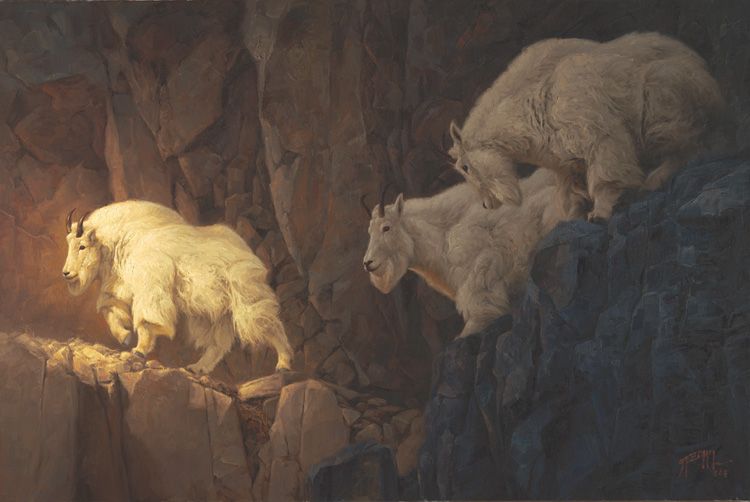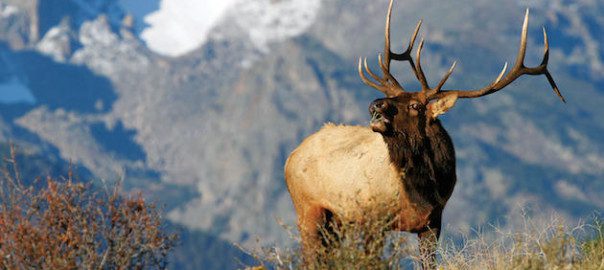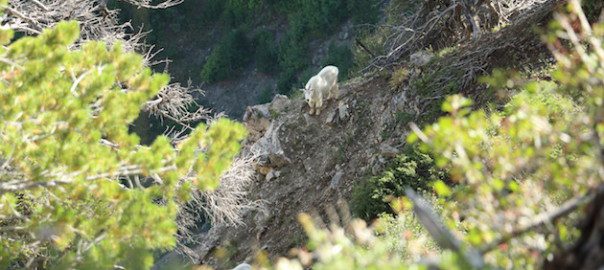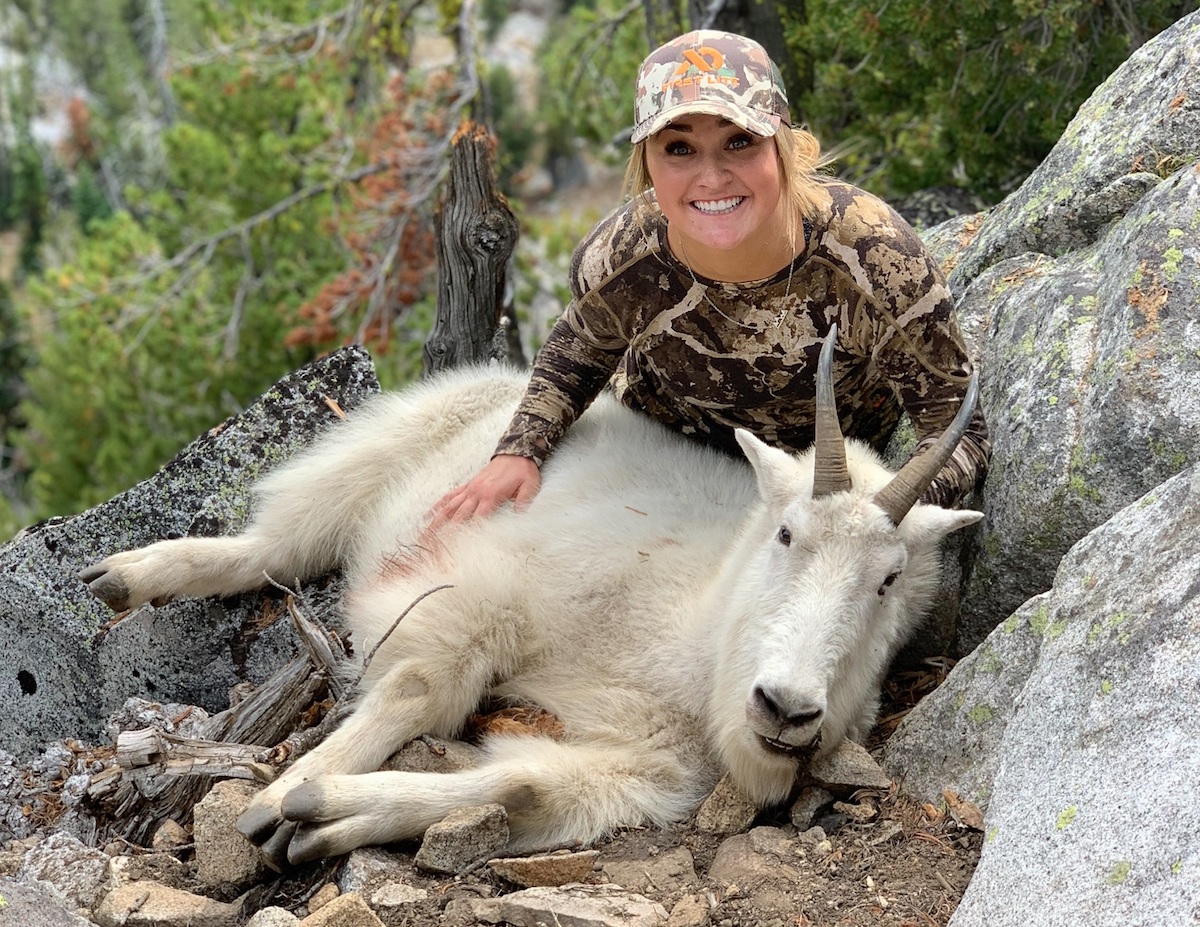For rugged grandeur and soundless solitude, pursue the majestic white goats in their mountain haunts.
Having hunted elk, sheep and other big game through the West in previous years, we were anxious to add a goat’s head to our modest collection. After many inquiries for a “sure place,” we started for Lake Chelan in the state of Washington.
We left the railway at Wenatchee, from which we had to go 35 miles by steamer to reach Chelan Falls.
From noon till midnight, we slowly pushed our way against the fierce currents and through the eddies of the river. Our boat disturbed large flocks of young wild ducks, in their summer breeding places, which, after vainly trying to keep ahead of us, became an easy prey to a so-called “sportsman,” who banged away at them from the deck for the mere pleasure of killing.
The riverbanks had been much washed by gold-seekers living in junks and equipped with their primitive placer outfits, were frequently seen washing their five dollars a day from those golden sands. With evening came glimpses of gorgeous forest fires, started now through the carelessness of the civilized, as in former days they had been lighted by the cunning of the native in order to drive the game during his fall hunting trip.
At last we were landed in total darkness on a sandbank, where a friendly lantern soon appeared and guided us through the sagebrush to a most comfortable hotel, which, with a few small houses, was all that the great spring freshet of 1894 had left of the once flourishing village of Chelan Falls.
In the crisp sunlight of early morning we climbed over the mountain toward the lake. Our road wound along the extreme edge of a rocky canyon, where a thousand feet below us the green river, crowned with rainbow arches, dashed itself into white spray clouds in its mad rush to the turbulent bosom of the gray Columbia. Next, Chelan appeared. Seen from a distance, it looked like a town of about 1,500 people, but a closer view showed that about four-fifths of the buildings were only windowless cabins, which marked the sites of vanished hopes and claims deserted when the boom died out.
Finally, we reached the lake, “the home of the white goat,” if reports proved true. Judging from appearances, they would. After a short delay, the little steamer, drawing only 22 inches of water, ran her bow upon the bank, and her captain escorted us to the deck. We found chairs covered with the entire goatskin, the sharp, black horns left on to serve as a possible hat rack, and with our feet buried in rugs of tangled white hair, we started on our journey of 70 miles through the canyon-like lake.
Its sides, after the first 20 miles, became huge towering rocks rising in places to 10,000 feet above our little “kick behind.” Occasionally we stopped, all the passengers lending a hand to “wood up” from the driftwood lying on the banks, then steamed on past the Wahpeto allotment, whose Native Americans have solved the problem of the transformation of the native into a tiller of the soil, and which boasts the only church in this part of the country conducted by Native American priests of the Roman Catholic faith. Past “painted rocks,” where the Siwash, but recently driven from his beloved hunting grounds, has told in picture language, for the benefit of brethren on the hunting trail, tales of miles traveled, trails followed, and game, such as goats, bear and deer, captured.
With eager eyes we watched for our first sight of a goat. We were often misled by a gnarled root or shining rock. At last we saw what appeared to be a patch of snow on the mountainside, but through our glasses it proved to be the coveted white goat as he surveyed our tiny steamer from the well-nigh inaccessible benches of Goat Mountain.
Toward evening we reached Stehe-kin, “The Pass,” where, after comfortably locating ourselves under Mr. Field’s hospitable roof, we demanded a goat. Not to be discouraged by the report that “the mountains look hard to climb but are lots harder than they look,” we started our hunt on one of those bright sunny mornings only found on the eastern slope of the Cascade Range.
Our companions were our host and a herculean guide, each carrying a pack containing bread, coffee and a pair of blankets. To my surprise, there seemed to be no special place from which to begin the hunt, for our guides said there were goats everywhere. We selected an “easy” mountain not far from the house, rowed to the foot, and commenced our skyward climb.
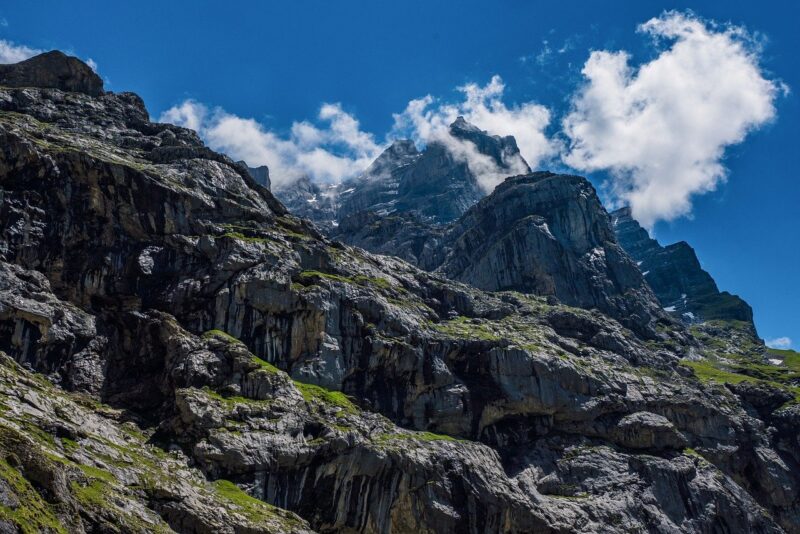 Hour after hour over soft, yielding earth, over pine carpets slippery as glass, over sharp, loose shale, over hot, ragged rocks, we zigzagged along, eagerly welcoming every old goat trail. Frequent stops were imperative. My rifle became strangely heavier and heavier. Now and again a rock slipped from under our feet and rolled far down the mountainside. Once, a big boulder, against which I had pushed in passing, rocked, slid, then bounded 200 yards through the air to be crushed into fragments that seemed like dust. Our way became steeper and steeper—an angle of 45 degrees—where, as our guide described it, “You have to stand up to sit down.”
Hour after hour over soft, yielding earth, over pine carpets slippery as glass, over sharp, loose shale, over hot, ragged rocks, we zigzagged along, eagerly welcoming every old goat trail. Frequent stops were imperative. My rifle became strangely heavier and heavier. Now and again a rock slipped from under our feet and rolled far down the mountainside. Once, a big boulder, against which I had pushed in passing, rocked, slid, then bounded 200 yards through the air to be crushed into fragments that seemed like dust. Our way became steeper and steeper—an angle of 45 degrees—where, as our guide described it, “You have to stand up to sit down.”
The first day passed without a sight of goats. They move up or down on the mountains according to the temperature, and we were unfortunate in hunting them when they had selected the moss near the snowbanks as their pasturage. In winter, they are easily found around the borders of the lake.
At evening we scraped out a narrow grave-like bed on the edge of an overhanging cliff. There were possible dangers from rockslides above us, and a sudden roll or incautious movement in our sleep might have landed us in eternity. It was a wonderful night—a bright new moon that sailed away, leaving only the glorious stars, crossed and re-crossed by numberless meteors.
Our fire had been carelessly lighted near some fallen timber, which soon became a broad sea of flame. Suddenly, with a mighty crash, the great logs slipped over the precipice, falling a thousand feet below, and carrying in their triumphal course, other trees, boulders and earth lighting up the midnight with a shower of eddying fire, leaving only darkness and cold behind. By daylight next morning we ate our bread and drank our café noir, made with water worth its weight in gold, for indeed it was as hard to find as goats.
Tantalus could hardly have suffered greater tortures than we did during those hours of scorching sunshine, when, parched with thirst, dripping with perspiration, and our lungs filled with dust, we looked down at the foot of the mountain, saw the beautiful, cold, blue lake, and realized how impossible it was to reach it.
Again we started with tired limbs, but brave hearts, for we began to see signs of goats, the V-shaped tracks, some old, some “since the rain”—a slight shower three days before—beds where they had lain, and bunches of wool caught on the branches.
Climbing now became steeper and breathing more painful. Suddenly, our guide signaled us to drop, and we saw our first “billy.” Alas! too late; he had already sighted us, and we heard the sound of tumbling rocks as he beat a hasty retreat over a narrow trail on the precipice above us. With new courage we clambered on, carefully watching each step lest we tread upon a “rattler.”
The only signs of life we saw on those mountaintops were goats, rattlesnakes, a small screech owl that had made its nest on a barren rock, and a bear that we routed from his bed as we struggled to find one for ourselves. Fortunately for him, his pelt was not worth securing, and the echoes of rifle shots must not be recklessly sounded in a goat country.
At last we gained the snow line, and, knowing that, our upward climb being over, we could now look down for our game, we took the glass to study our surroundings. On a distant spur, boldly outlined against the sky, was a billy, dignified, assured of his position, silently looking down, always down, upon the puny little world beneath him. To us he looked like a great polar bear but as he climbed to a still bolder spur, he appeared more like an albino buffalo.
His black horns glistened in the sunlight and his white mane stood erect as he gazed in solemn meditation upon the scene below. And, indeed, it was a grand picture. One vast sea of snow-capped peaks filled the entire horizon; in the distance, great glaciers seamed with gray-blue crevasses, and, 9,000 feet below us, the lake, rivaling in blueness even the famed color of the Bahaman waters, a narrow ribbon dividing the steep green cliffs on either side.
The noise of rolling stones startled the billy. He wakened from his lethargy, listened, climbed with a slow, rolling gait to a still higher bench, and waited, but not for us; he was too far and we too feeble to follow his wanderings.
Again through the glass we saw, a quarter of a mile directly below us, what under the shadow of some pines looked like deer but proved to be a small bunch of goats. So we determined to try the descent. Going down was even worse than climbing up. Every step was followed by an avalanche of loose slide-rock, but we had seen the quarry and must reach it.
We silently stole behind a sharp spur of rock, fearing, from a slight dust we saw arise, that our game had taken flight. Cautiously we crawled forward to find the goats within easy range. Two sharp reports rang from the .45-70 Winchesters, and at our feet lay Nannie, while Billy rolled over and over down the rocky cliff until he was lost to view. An hour later we found him caught in some rocks at the foot of the canyon.
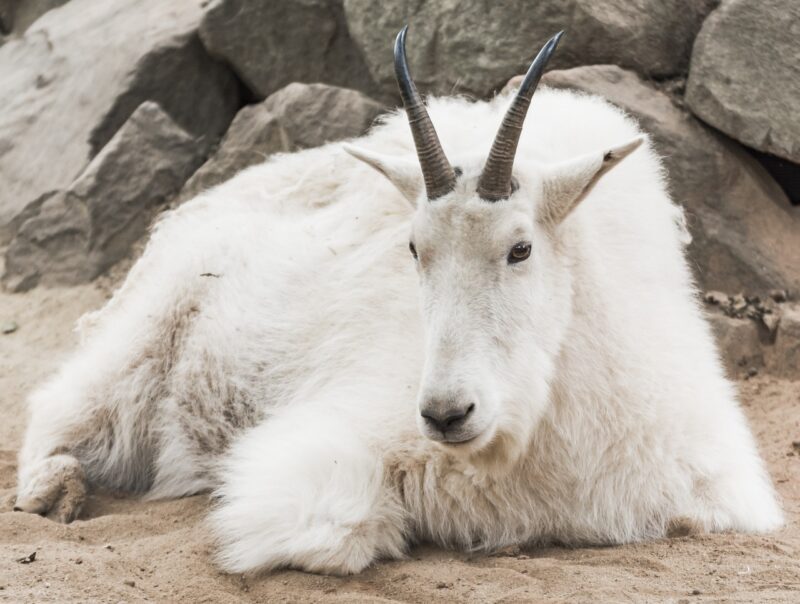 Our work was done. After securing both heads and skins, we found that Nannie’s head, with its stiletto-like horns, was even more shapely than Billy’s.
Our work was done. After securing both heads and skins, we found that Nannie’s head, with its stiletto-like horns, was even more shapely than Billy’s.
Our shortest way appeared to be down a dry mountain torrent course; what a fatal mistake! We wearily slid hour after hour over round, smooth boulders; the “devil’s walking-stick” tore our hands and faces; a windfall had filled the dry watercourse with logs of all shapes and sizes, over which we clambered, stumbled, slipped, until finding ourselves still four miles from the lake with darkness overtaking us, we cried a halt.
Once more our faithful guide scraped out a bed for us on those unfriendly rocks, where, with our feet propped up by an improvised stone wall, we were comparatively safe. Anyway, it was the best we could do, and although we had no supper, we wrapped our blankets around us and fell asleep.
Oh, the joy of finding in the morning a stream of cold running water, where, stretched flat upon the ground, we could drink. After that we had a breakfast, which need not be described.
I may never stalk goats again. It is easier to hunt in a country where a patient bronco may assist in tracking the game, but for rugged grandeur and soundless solitude, commend me to the haunts of the white goats.
The Rocky Mountain goat is not a true goat, but an antelope that masquerades in goat’s clothing. He is unique in living where other game would die and dying where other game would live. A goat in confinement soon dies. Our guide suggested that it was for the need of some plant only found among the mosses and lichens of their rocky haunts. The goat, therefore, enjoys the proud distinction of not having contributed either to the circus tent or zoological garden.
He scorns the protection of a coat that changes color with the autumn leaves and proudly flaunts at all seasons the white of the everlasting snow. He seems to be a distinctively American production, only found in the extreme northwestern part of our country and across the line in British Columbia. He differs essentially from his cousin of the Himalayas, the grayish-brown paseng of Persia, or the chamois of Europe. He has neither the fatal inquisitiveness of the plains antelope, the timidity of the deer, nor the cunning of the sheep. He is as deliberate as a bear and, if approached from above, as reckless as a caribou.
Yet such is the wisdom of this meditative antelope-goat that, while we lament the vanished buffalo, the vanishing moose and other large game, nearly all writers agree that the goat, instead of being in danger of extermination, is slowly increasing. The Native Americans, supplied with blankets by Uncle Sam, need no longer use his wool; his musky and unpalatable flesh offers no temptation to the epicure; even the cougar and wolf rarely disturb him in his isolated haunts.
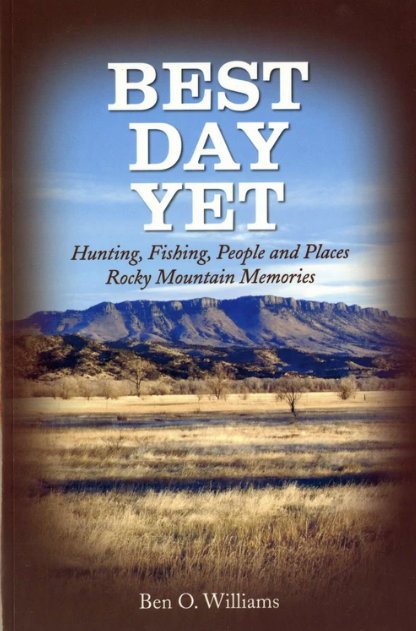 This book is a collection of the author’s true-shared essays of outdoor activities and of the folks he has encountered on the Great High Plains. It’s Ben’s Rocky Mountain Memories of hunting, fishing, people and places. This book has a far wider appeal than just for the hunting and fishing audience. No matter where you live, or what age, or in what walk of life you live, one of these essays will revive your memory of an experience in some way you had or someone in your family has handed down to you. Buy Now
This book is a collection of the author’s true-shared essays of outdoor activities and of the folks he has encountered on the Great High Plains. It’s Ben’s Rocky Mountain Memories of hunting, fishing, people and places. This book has a far wider appeal than just for the hunting and fishing audience. No matter where you live, or what age, or in what walk of life you live, one of these essays will revive your memory of an experience in some way you had or someone in your family has handed down to you. Buy Now

